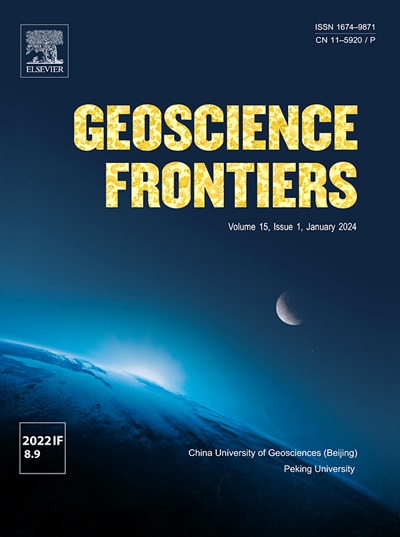Early Jurassic carbon cycle perturbations recorded in terrestrial sediments of the Sichuan Basin, China
IF 8.9
1区 地球科学
Q1 GEOSCIENCES, MULTIDISCIPLINARY
引用次数: 0
Abstract
The Toarcian Oceanic Anoxic Event (T-OAE, ∼183 Ma) is marked in the sedimentary record by a sharp negative carbon isotope excursion, thought to be causally linked to the emplacement of the Karoo-Ferrar Large Igneous Province and the associated release of 12C-enriched carbon. The T-OAE coincided with global climate and environmental changes, as well as biotic events, indicating substantial modifications in ecosystems. Recent studies have focused on the evidence of geological responses to the T-OAE in Early Jurassic terrestrial basins in China, particularly the Sichuan Basin. Nevertheless, debate remains over the identification of this event, owing to inadequate age-constraints of many sections, and a lack of robust correlations of the carbon isotope records. Moreover, the long-term evolution of the terrestrial carbon isotope record through the Early Jurassic, and its correlation to marine records, is still not firmly established. In this paper, we present new carbon isotope analyses of carbonate (δ13Ccarb) from lacustrine carbonates and terrestrial organic matter (δ13Corg) from bulk rocks within the Ma’anshan and Da’anzhai members of the Ziliujing Formation from the Dacao ‘D’ (DCD) section in the eastern Sichuan Basin. Palynological-palynofacies analysis reveals a predominance of Classopollis pollen together with marker taxa such as Ischyosporites variegatus, Contignisporites problematicus, in the palynological assemblage, indicating a Pliensbachian–Toarcian age. A negative carbon isotope excursion (NCIE) is recorded in the organic carbon isotope data at the topmost part of the Pliensbachian Ma’anshan Member, which can be correlated to the Pliensbachian–Toarcian Boundary Event. This is followed, in the Toarcian Da’anzhai Member, by a major NCIE recorded in both organic matter and carbonate carbon isotope data which can be correlated to the T-OAE NCIE. A long-term carbon isotope record spanning the Sinemurian to Toarcian in Sichuan terrestrial sediments is also been reconstructed and its correlation with coeval marine records is proposed. A broader review of δ13C data from Chinese terrestrial basins spanning the Pliensbachian–Toarcian highlights a distinct 13C-depleted signature in the Sichuan Basin compared to basins at higher latitudes. Changes in latitudinal gradients and organic matters in the lake sediments were likely important factors influencing the amplitudes of the T-OAE NCIE and the carbon isotope values in terrestrial sedimentary records.

四川盆地陆相沉积物早侏罗世碳循环摄动记录
Toarcian Oceanic缺氧事件(T-OAE, ~ 183 Ma)在沉积记录中以急剧的负碳同位素偏移为标志,被认为与Karoo-Ferrar大火成岩省的侵位和相关的12c富集碳的释放有因果关系。T-OAE与全球气候和环境变化以及生物事件相吻合,表明生态系统发生了实质性变化。近年来的研究主要集中在中国早侏罗世陆相盆地,特别是四川盆地对T-OAE的地质响应证据。然而,由于许多剖面的年龄限制不足,以及碳同位素记录缺乏可靠的相关性,对这一事件的识别仍然存在争议。此外,早侏罗世陆相碳同位素记录的长期演化及其与海洋记录的相关性仍未完全确定。本文介绍了川东大草D剖面自流井组马鞍山组和大安寨组大块岩石中湖泊碳酸盐(δ13Ccarb)和陆相有机质(δ13Corg)的新碳同位素分析结果。孢粉-孢相分析显示,孢粉组合中以Classopollis花粉为主,并伴有Ischyosporites variegatus、Contignisporites problematicus等标记分类群,表明其孢粉时代为pliensbachia - toarcian。Pliensbachian - toarcian边界事件与马鞍山段最上部有机碳同位素记录有负碳同位素偏移(NCIE)。随后,在大安寨段,在有机质和碳酸盐碳同位素数据中记录了一个主要的NCIE,可以与T-OAE NCIE相关联。重建了四川陆相沉积物中横跨新木里纪至托瓦纪的长期碳同位素记录,并提出了与同期海相记录的对比。对中国陆相盆地的δ13C数据进行了更广泛的回顾,发现四川盆地与高纬度地区的盆地相比具有明显的13c亏缺特征。纬度梯度和湖泊沉积物有机质的变化可能是影响T-OAE NCIE振幅和陆相沉积记录碳同位素值的重要因素。
本文章由计算机程序翻译,如有差异,请以英文原文为准。
求助全文
约1分钟内获得全文
求助全文
来源期刊

Geoscience frontiers
Earth and Planetary Sciences-General Earth and Planetary Sciences
CiteScore
17.80
自引率
3.40%
发文量
147
审稿时长
35 days
期刊介绍:
Geoscience Frontiers (GSF) is the Journal of China University of Geosciences (Beijing) and Peking University. It publishes peer-reviewed research articles and reviews in interdisciplinary fields of Earth and Planetary Sciences. GSF covers various research areas including petrology and geochemistry, lithospheric architecture and mantle dynamics, global tectonics, economic geology and fuel exploration, geophysics, stratigraphy and paleontology, environmental and engineering geology, astrogeology, and the nexus of resources-energy-emissions-climate under Sustainable Development Goals. The journal aims to bridge innovative, provocative, and challenging concepts and models in these fields, providing insights on correlations and evolution.
 求助内容:
求助内容: 应助结果提醒方式:
应助结果提醒方式:


